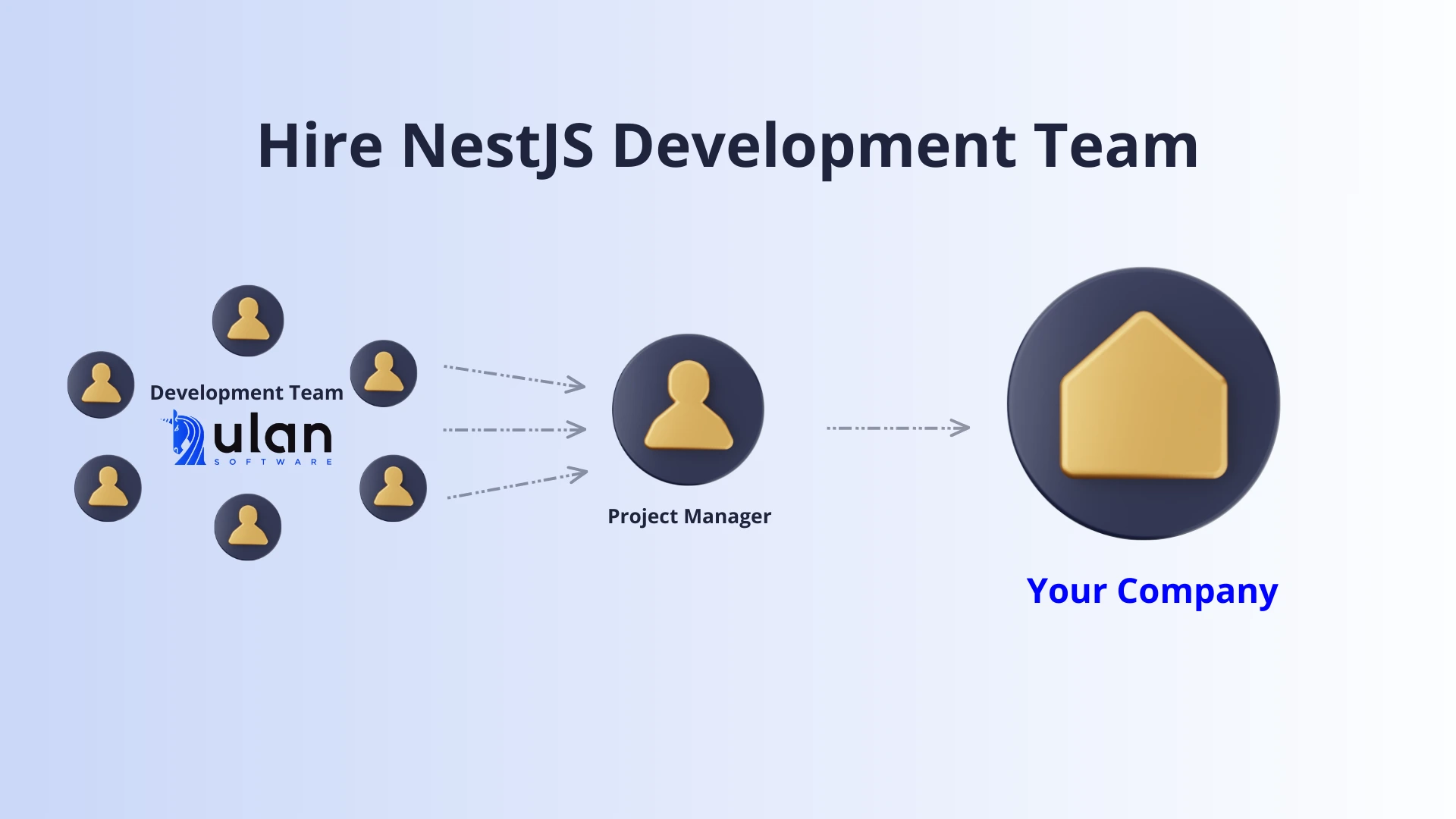Back to all Articles
Why Choose NestJs Framework for Building Server-side Apps
Updated:
Thu, Apr 17
Reading time: 10 minutes

Choosing the right backend framework is a big decision for any CTO or lead developer. You need something that’s scalable, easy to maintain, and developer-friendly. All while keeping operations smooth.
NestJS has become a go-to option for many companies, especially in enterprise projects. It brings structure to Node.js development, enforces best practices, and helps teams stay organized.
At Ulan Software, we’ve been using NestJS for years to build scalable backend systems. We’ve seen firsthand how it simplifies development and helps teams collaborate better.
However, like any technology, it’s not a one-size-fits-all solution. In this article, we’ll share our perspective on when and why to consider NestJs framework for projects.
NestJS has become a go-to option for many companies, especially in enterprise projects. It brings structure to Node.js development, enforces best practices, and helps teams stay organized.
At Ulan Software, we’ve been using NestJS for years to build scalable backend systems. We’ve seen firsthand how it simplifies development and helps teams collaborate better.
However, like any technology, it’s not a one-size-fits-all solution. In this article, we’ll share our perspective on when and why to consider NestJs framework for projects.
Why NestJS is a Good Framework?
At Ulan Software, we don’t just choose NestJS because it’s trendy. We chose it because it solves real technical challenges in complex backend development.
Over the years, we’ve used NestJS to architect high-performance applications (for example drivery service app for IKEA), scale microservices, and enforce clean code standards.
Unlike many frameworks that promise structure but end up limiting flexibility, NestJS strikes a unique balance between enterprise-grade organization and developer autonomy.
From our experience, here’s why NestJS stands out as a smart choise for backend development:
Over the years, we’ve used NestJS to architect high-performance applications (for example drivery service app for IKEA), scale microservices, and enforce clean code standards.
Unlike many frameworks that promise structure but end up limiting flexibility, NestJS strikes a unique balance between enterprise-grade organization and developer autonomy.
From our experience, here’s why NestJS stands out as a smart choise for backend development:
Enterprise-ready & clean code structure
We believe NestJS is the most enterprise-ready and clean-code framework for Node.js. At Ulan Software, we’ve used it for years to build backend systems that need to scale. In contrast to Express or Fastify (more flexibility but less structure), NestJS enforces modular architecture. This makes it easier to manage large codebases, especially when working with big teams.
One of the biggest advantages? It keeps everything organized. When multiple developers work on the same project, things can get messy fast. NestJS forces a structured approach, so teams follow the same patterns. That means less confusion, easier onboarding, and fewer bugs in the long run.
One of the biggest advantages? It keeps everything organized. When multiple developers work on the same project, things can get messy fast. NestJS forces a structured approach, so teams follow the same patterns. That means less confusion, easier onboarding, and fewer bugs in the long run.
Strong Dependency Injection (DI) System
One of the best things about NestJS is its built-in Dependency Injection (DI). At Ulan Software, we’ve used it to keep our projects modular, testable, and easy to maintain.
Unlike Express or Fastify, NestJS has DI by default. You don’t need extra libraries or custom setups. It helps maintain coupling between different parts of the application. So you can replace, update, or test components without breaking the whole system.
For enterprise projects, this structure is a huge advantage. Teams working on the same codebase need clear separation of logic. NestJS forces a consistent approach, making development smoother and reducing technical debt.
Unlike Express or Fastify, NestJS has DI by default. You don’t need extra libraries or custom setups. It helps maintain coupling between different parts of the application. So you can replace, update, or test components without breaking the whole system.
For enterprise projects, this structure is a huge advantage. Teams working on the same codebase need clear separation of logic. NestJS forces a consistent approach, making development smoother and reducing technical debt.
Faster Onboarding & Consistent Codebase
NestJS provides a clear project structure. Every module, service, and controller follows the same pattern. This makes it easier to onboard new developers and keeps the codebase clean and predictable. No more wasting time figuring out different coding styles - everyone follows the same rules.
For big teams, this is a game-changer. When multiple developers work on the same project, things can quickly get messy. NestJS reduces confusion by enforcing repeatable patterns. This makes collaboration smoother and speeds up development.
For big teams, this is a game-changer. When multiple developers work on the same project, things can quickly get messy. NestJS reduces confusion by enforcing repeatable patterns. This makes collaboration smoother and speeds up development.
Type Safety & Automatic Validation
NestJS is built with TypeScript by default. This means type safety is guaranteed across the entire application. In our projects, we’ve seen how this reduces bugs and makes development smoother.
With NestJS, you skip manual parameter checks in upcoming requests and local values. The framework handles validation automatically using decorators. This reduces runtime errors and saves time on debugging.
Another big win is automatic API documentation. NestJS integrates with Swagger, so every endpoint is documented without extra effort. Developers get clear, up-to-date API references without extra work.
With NestJS, you skip manual parameter checks in upcoming requests and local values. The framework handles validation automatically using decorators. This reduces runtime errors and saves time on debugging.
Another big win is automatic API documentation. NestJS integrates with Swagger, so every endpoint is documented without extra effort. Developers get clear, up-to-date API references without extra work.
Built-in Features & Ecosystem
NestJS comes with built-in tools that speed up development. Features like authentication (JWT, Passport etc.), caching, and validation work right out of the box, so you don’t have to set them up from scratch.
For larger applications, NestJS makes scaling easier. The framework supports microservices by default. This allow dev teams break big systems into smaller, independent services. If your project needs high performance and flexibility, NestJS provides a solid foundation to build on.
For larger applications, NestJS makes scaling easier. The framework supports microservices by default. This allow dev teams break big systems into smaller, independent services. If your project needs high performance and flexibility, NestJS provides a solid foundation to build on.
When NestJs is the Best Fit?
For the last years, we’ve seen more companies choose Node.js to build backend applications. It’s fast, scalable, and widely used. But while Node.js provides flexibility, it doesn’t enforce structure.
That’s where NestJS comes in. It builds on Node.js, adding a modular architecture, strong typing, and built-in features. Here's when you should consider choosing NestJs framework:
When you're building an enterprise-level app. Enterprise projects require a structured, maintainable, and scalable codebase. NestJS enforces modular architecture and best practices, making it a great choice for companies that need stability and long-term support.
When it’s a large team project. Big teams mean more developers working on the same codebase. NestJS enforces consistency, reducing the risk of messy code and making onboarding easier. Teams follow the same patterns, which leads to faster collaboration and fewer conflicts.
When you need a microservices architecture. If your project is moving toward distributed systems, NestJS offers built-in microservices support. It helps manage multiple services while keeping the codebase modular and avoiding unnecessary complexity. When strong validation and API documentation matter. NestJS automates Swagger documentation and has built-in validation using decorators. This means developers spend less time writing docs and handling data validation manually.
When your project needs to scale. NestJS supports long-term growth with its modular design and Dependency Injection system. It keeps the code clean and makes it easier to expand without losing structure.
When transitioning from another stack to Node.js. Moving to Node.js can be challenging. Especially for teams used to strictly structured frameworks like .NET or Spring Boot. NestJS provides a familiar, opinionated approach and makes the transition smoother.
That’s where NestJS comes in. It builds on Node.js, adding a modular architecture, strong typing, and built-in features. Here's when you should consider choosing NestJs framework:
When you're building an enterprise-level app. Enterprise projects require a structured, maintainable, and scalable codebase. NestJS enforces modular architecture and best practices, making it a great choice for companies that need stability and long-term support.
When it’s a large team project. Big teams mean more developers working on the same codebase. NestJS enforces consistency, reducing the risk of messy code and making onboarding easier. Teams follow the same patterns, which leads to faster collaboration and fewer conflicts.
When you need a microservices architecture. If your project is moving toward distributed systems, NestJS offers built-in microservices support. It helps manage multiple services while keeping the codebase modular and avoiding unnecessary complexity. When strong validation and API documentation matter. NestJS automates Swagger documentation and has built-in validation using decorators. This means developers spend less time writing docs and handling data validation manually.
When your project needs to scale. NestJS supports long-term growth with its modular design and Dependency Injection system. It keeps the code clean and makes it easier to expand without losing structure.
When transitioning from another stack to Node.js. Moving to Node.js can be challenging. Especially for teams used to strictly structured frameworks like .NET or Spring Boot. NestJS provides a familiar, opinionated approach and makes the transition smoother.
What Companies Using NestJS?
NestJS has gained strong adoption among startups, enterprises, and tech-driven companies. Just because it is easier to use, easier to test and easier to maintain the code.
Many finance, e-commerce, SaaS, and enterprise software companies rely on NestJS for their backend services. According to Enlyft, 7,976 companies use NestJS, with a significant presence in the United States. Some major companies using NestJS include:
These companies use NestJS to handle complex, high-traffic applications while ensuring long-term maintainability. It’s a preferred choice for teams that want both the flexibility of Node.js and the structure of an enterprise-ready framework.
Many finance, e-commerce, SaaS, and enterprise software companies rely on NestJS for their backend services. According to Enlyft, 7,976 companies use NestJS, with a significant presence in the United States. Some major companies using NestJS include:
- Adidas – One of the world’s largest sportswear brands, using NestJS to manage its digital ecosystem.
- Capgemini – A global consulting and technology company that builds enterprise-grade applications.
- Decathlon – A multinational sporting goods retailer leveraging NestJS for its digital platforms.
- Autodesk – A leader in 3D design and engineering software.
These companies use NestJS to handle complex, high-traffic applications while ensuring long-term maintainability. It’s a preferred choice for teams that want both the flexibility of Node.js and the structure of an enterprise-ready framework.
💡 Need help with your NestJS Project?
Reach out to our experts today!
Reach out to our experts today!
When Not to Use NestJs?
NestJS is powerful, but it’s not the best choice for every project. Sometimes, a lighter, more flexible framework might be a better fit. Here are some cases where you might want to look at alternatives:
When you need a lightweight framework. NestJS comes with a lot of structure and extra files. This makes it great for large projects but too heavy for small apps that don’t need strict architecture. Express or Fastify might be a better choice if you want something lean and simple.
When you need the absolute fastest performance. Performance isn’t usually the biggest factor when choosing a framework, but if speed is critical, a plain Fastify setup might work better. It avoids extra layers and provides built-in performance optimizations.
When you want complete flexibility. NestJS enforces a strict project structure, which might feel restrictive if you prefer more control. Express or Fastify give you full freedom to structure your app however you want.
When your microservice has a very small dependency chain. NestJS works well for complex backend systems, but if you’re building a small, isolated microservice, it might be overkill. A lighter Node.js framework could be a better fit.
Before choosing NestJS, think about your project’s size, architecture, and flexibility needs.
If you need a structured and scalable framework, it’s a great choice. But for small, fast, or serverless applications, a simpler alternative might be the way to go.
When you need a lightweight framework. NestJS comes with a lot of structure and extra files. This makes it great for large projects but too heavy for small apps that don’t need strict architecture. Express or Fastify might be a better choice if you want something lean and simple.
When you need the absolute fastest performance. Performance isn’t usually the biggest factor when choosing a framework, but if speed is critical, a plain Fastify setup might work better. It avoids extra layers and provides built-in performance optimizations.
When you want complete flexibility. NestJS enforces a strict project structure, which might feel restrictive if you prefer more control. Express or Fastify give you full freedom to structure your app however you want.
When your microservice has a very small dependency chain. NestJS works well for complex backend systems, but if you’re building a small, isolated microservice, it might be overkill. A lighter Node.js framework could be a better fit.
Before choosing NestJS, think about your project’s size, architecture, and flexibility needs.
If you need a structured and scalable framework, it’s a great choice. But for small, fast, or serverless applications, a simpler alternative might be the way to go.
What are Common Issues With Nestjs?
While NestJS offers a structured and scalable approach to backend development, it is not without its challenges. Many developers face specific issues when working with this framework.
Below we will describe some of them and share our experience how our dev teams tackle these issues.
Below we will describe some of them and share our experience how our dev teams tackle these issues.
Circular Dependencies
One of the biggest problems in NestJS projects is circular dependencies. This happens when two or more modules depend on each other, creating a loop. It can lead to runtime errors, slow development, and difficult debugging.
NestJS acknowledges this issue, and tools like Madge or nestjs-spelunker help detect it early.
However, this is not a NestJS problem—it’s an architectural issue. The best way to avoid it is to structure modules properly. Feature-based separation and loosely coupled modules help prevent circular dependencies from forming.
NestJS acknowledges this issue, and tools like Madge or nestjs-spelunker help detect it early.
However, this is not a NestJS problem—it’s an architectural issue. The best way to avoid it is to structure modules properly. Feature-based separation and loosely coupled modules help prevent circular dependencies from forming.
Using Testing Complexity
NestJS has built-in testing tools, but unit testing can get complicated. The Dependency Injection (DI) system, while useful for architecture, adds extra steps to writing tests. Some teams spend more time managing dependencies than testing actual business logic.
One way to simplify testing is by moving core logic into standalone functions instead of class methods. This makes tests easier to write and maintain, and it helps new developers understand the code faster.
One way to simplify testing is by moving core logic into standalone functions instead of class methods. This makes tests easier to write and maintain, and it helps new developers understand the code faster.
Over-Reliance on the Framework
Some developers tie their business logic too closely to NestJS. Features like decorators and modules make development easier, but they can also lock your code into the framework. If you ever need to switch to a different stack, migration becomes difficult.
A good practice is to keep core business logic framework-agnostic. Writing reusable, independent services allows more flexibility if you need to move away from NestJS in the future.
A good practice is to keep core business logic framework-agnostic. Writing reusable, independent services allows more flexibility if you need to move away from NestJS in the future.
Hire NestJs Developers
If you're looking for experienced NestJS developers, Ulan Software can help you find the right talent for your project. Whether you need a single developer to augment your in-house team or require specialized expertise for a short-term engagement, we provide top-tier NestJS developers who can integrate seamlessly into your workflow.

Why hire NestJS Developers from Ulan Software?
Why hire NestJS Developers from Ulan Software?
- Proven Expertise. Our developers have extensive experience working with NestJS on real-world projects. We understand best practices, scalability challenges, and efficient code organization.
- Flexible Engagement Models. Whether you need full-time, part-time, or project-based developers, we offer flexible hiring models to fit your requirements.
- Quick Onboarding. We ensure that our developers get up to speed fast, minimizing downtime and accelerating project timelines.
- Cost-Effective. Hiring through Ulan Software ensures you get top-tier talent without the overhead costs of full-time employment.
- With our expertise in NestJS development, we can help you accelerate backend development, improve code maintainability, and build scalable applications. Whether you need support for a new mvp development project or additional hands for an ongoing one, our developers are ready to contribute immediately.
Hire NestJS Development Team
For businesses looking to build a dedicated NestJS development team, Ulan Software offers a team of highly skilled engineers who specialize in backend development using NestJS.
Whether you're a startup scaling your technology stack or an enterprise handling complex backend architectures, we provide end-to-end solutions tailored to your needs.
Whether you're a startup scaling your technology stack or an enterprise handling complex backend architectures, we provide end-to-end solutions tailored to your needs.

Why Build a NestJS Team with Ulan Software?
- Custom-Built Teams – We assemble a dedicated software development team based on your specific requirements, ensuring the right mix of skills and expertise.
- Full Development Lifecycle Support – From architecture design and development to deployment and maintenance, we cover every aspect of your backend needs.
- Agile & Scalable Teams – As your business grows, we help scale your NestJS team seamlessly, adding more developers or specialized roles as needed.
- Industry Best Practices – Our teams follow enterprise-level coding standards, modular architectures, and scalable solutions to keep your backend efficient and maintainable.
- Managed or Collaborative Model – You choose between a fully managed NestJS development team or have our experts work alongside your internal teams.
At Ulan Software, we don’t just provide developers—we offer a strategic partnership that helps you deliver high-performance applications with NestJS.
For businesses looking to build a dedicated NestJS development team, Ulan Software offers a team of highly skilled engineers who specialize in backend development using NestJS.
Whether you're a startup scaling your technology stack or an enterprise handling complex backend architectures, we provide end-to-end solutions tailored to your needs.
Conclusion
NestJS is a powerful and opinionated framework that brings enterprise-grade architecture, modularity, and TypeScript-first development to Node.js applications. It is particularly well-suited for large teams, scalable applications, and companies that value clean code structure and maintainability.
If your goal is to build a structured and scalable backend with a focus on developer experience, NestJS is one of the best choices in the Node.js ecosystem today.
If your goal is to build a structured and scalable backend with a focus on developer experience, NestJS is one of the best choices in the Node.js ecosystem today.
Wojciech Andruszków
Wojciech is experienced CTO. Over the past 15 years he has led high-profile projects for major financial institutions such as Standard Chartered, UBS, RBS, and NatWest, managing projects worth over £1 billion.
Table of Contents:
Why NestJs is a good framework?
When NestJs is the best fit?
What companies using NestJs?
When not to use NestJs?
What are common issues with Nestjs?
Hire NestJs developers
Hire NestJs development team
Conclusion
Recommended Articles
Tue, Nov 25
How to Choose the Best Marketplace Software?
Learn how to choose the best marketplace software with a clear, step-by-step guide. Compare models, features, scale, cost, and vendor fit to make a confident choice.
Thu, Nov 20
Top 15 UX Tips to Improve Conversion Rates in Travel Booking
Improve travel booking flow conversion with 15 proven UX tips. Learn how mobile design, pricing clarity, speed, and smart flows reduce friction and lift bookings.
Mon, Nov 17
What to Look for in Enterprise Booking Software?
Learn what to look for in enterprise booking software: key features, integrations, security, and data to guide your 2025 selection.


